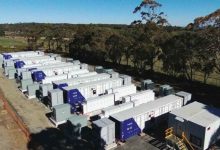US battery storage technology company Fluence is proposing two big batteries – each of 250MW and 30 minute storage – could be installed as a faster and potentially cheaper solution to solve the transmission limits between the two biggest electricity markets in Australia, NSW and Victoria.
The proposal by Fluence – which built the 30MW/30MWh Ballarat Energy Storage System in Victoria, (pictured above) one of two big batteries that operate in the state – is revealed in a series of submissions made to the Australian Energy Market Operator as it canvasses options to increase the capacity of transfers between NSW and Victoria.
Fluence – a joint venture between Siemens and AES – is proposing two 250MW/125MWh battery-based energy storage systems (one in Wagga Wagga and the other in Morang) that it says will help AEMO and TransGrid address transmission network congestion issues.
It argues that the two batteries – which could operate in unison, with one charging at one end while the other discharges at the other end, and so increase the transmission flows – could be up in running within 18 months, far quicker than any traditional “network option” which would likely only be completed in 2027/28. And it can be scaled.
“Operating BESS units at Wagga Wagga and South Morang in tandem to create a virtual transmission line (one system discharging, the other charging) can help both import and export capability between New South Wales and Victoria,” it says.
“This additional support on either end of the transmission interconnector will enable more efficient use of the existing lines, alleviating current and future limitations.”
The batteries as proposed would be significantly larger than the large-scale batteries currently deployed in Australia, including Neoen’s Hornsdale Power Reserve in SA – aka the Tesla big battery – which is being expanded to 150MW/194MWh from its current world-leading capacity of 100MW/129MWh.
Neoen, however, is proposing an even bigger alternative for the Victoria transmission link issues, submitting a proposal for a 600MW “Victoria big battery (with an as yet unspecified storage time) to be installed near Geelong as part of a separate process launched by the Victoria government to by-pass the sometime convoluted and drawn out regulatory investment test process that the market operator must normally follow.
Fluence makes reference to this proposal – although not specifically the Neoen submission – suggesting that the two differing proposals and programs could be compatable.
If Neoen’s Victoria big battery, or a similar addition, went ahead on the Victoria side of the transmission line, for instance, then Fluence’s proposal could apply only to Wagga Wagga on the NSW side, before more such “pairs” could be considered in other upgrades or new links, such as the new VNI West line favoured by AEMO.
Fluence says its proposal for a “virtual transmission line” solution will add much needed capacity to the Victoria-NSW interconnector, “widening the highway” to facilitate more large-scale electricity transfers between NSW and Victoria.
It also sees it as a blue-print for the future, with battery storage now touted as a more efficient and scaleable way to expand and augment existing transmission lines as networks assess needs moving forward. The regulator has already supported this idea after approving a traditional network upgrade to the main link between NSW and Queensland.
“The speed of installing and commissioning BESS assets is a significant advantage to planning, building and commissioning network assets,” it says.
“Fluence believes that BESS of these scale and sizes could be installed and commissioned within in a 14-18 month timeframe – likely faster than network assets and requiring far less effort in securing easements and rights-of-way – which can bring significant benefits for the overall network. No other traditional transmission option can be implemented in such a short timeframe to provide additional dispatchable capacity.”
Fluence says its proposal also offers both scale and flexibility, as well as speed.
“Our proposal for two 250MW BESS of 30-minute duration can be deployed, and in 2023, 2025 and 2027 expansions can be evaluated that may eventually provide the same (traditional transmission) capacity increases illustrated in the options below,” it says.
“If the network flows change significantly by 2023, it may be that none of the options below would be adequate and a larger investment would be needed, and BESS deployment offers that flexibility.
“Alternatively, the BESS investment today enables AEMO and TransGrid to thenevaluate a more “right-sized” upgrade of the transmission line, while receiving the benefits of the already installed BESS until and after the upgrade of the transmission line is completed.”
RenewEconomy and its sister sites One Step Off The Grid and The Driven will continue to publish throughout the Covid-19 crisis, posting good news about technology and project development, and holding government, regulators and business to account. But as the conference market evaporates, and some advertisers pull in their budgets, readers can help by making a voluntary donation here to help ensure we can continue to offer the service free of charge and to as wide an audience as possible. Thank you for your support.








